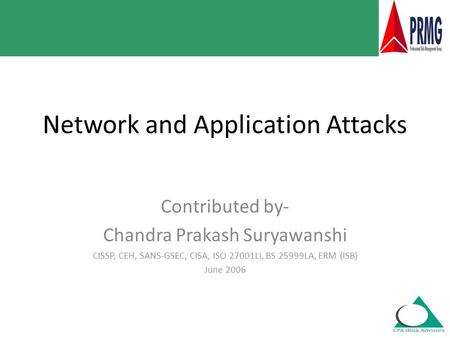


Distributed Denial of Service Yi Zhang April 26, 2016
Outline DDoS Overview DDoS Attacks and Defenses DDoS Defense by Offense
DDoS Overview DDoS is a type of DoS attack where an attacker uses a large number of compromised hosts to exhaust resources (e.g. bandwidth, CPU, memory and etc.) of a target An important factor in DDoS is the amplification effect Botnet amplification Network-layer amplification and spoofed requests Application-layer amplification
DDoS Attacks Past DDoS attacks were mainly Layer 3/ Layer 4 Attacks.
Layer 3 DDoS Attack Layer 3 DDoS attack floods TCP/UDP/ICMP/IGMP packets, overloads infrastructure due to high rate processing/discarding of packets and fills up the packet queues, or saturate pipes Example UDP flood to non-listening port
Layer 4 DDoS Attack Layer 4 DDoS attack is more sophisticated. It consumes extra memory, available connections Examples TCP SYN flood TCP new connections flood TCP concurrent connections exhaustion
Layer 7 DDoS Attack Layer 7 DDoS attack abuses the server memory and performance limitations – masquerading as legitimate transactions Examples HTTP POST/GET flood DNS query flood Low rate, high impact attacks – e.g. Slowloris, HTTP POST DoS
HTTP GET DDoS Attack
HTTP POST DDoS Attack
DDoS Defenses Over-provision massively Purchase enough resources to serve attackers and good clients Detection and blocking Distinguish between good and bad clients E.g. IP address profiling/CAPTCHA-based defenses/capabilities Charging all clients in a currency An attacked server gives a client service only after it pays some currency Currency: CPU/memory cycles, money, bandwidth
DDoS Defense by Offense Michael Walfish, Mythili Vutukuru, Hari Balakrishnan, David Karger, and Scott Shenker
Overview This paper proposes a defense mechanism known as Speak Up to defend servers against application-level DDoS attacks The idea is to encourage all clients to speak up that is automatically send more traffic to an attacked server Only good clients can react to encouragement as they use a small fraction of their available bandwidth and thereby they capture more of the server
Threat Model A server is any network-accessible service with scarce computational resources An attacker is an entity this is trying to deplete server’s resources with legitimate-looking requests. Attackers send traffic from botnets and the server has no easy way to tell from a single request with ill intent Servers cannot determine a request’s difficulty a priori
Applicability Conditions Adequate Link Bandwidth There must be enough spare bandwidth to allow for speak-up inflate traffic Adequate Client Bandwidth The aggregate bandwidth of all good clients must be on the same order of magnitude (or more) than the attackers’ No pre-defined clientele Non-human clientele Unequal request or spoofing or smart bots
Design of Speak-up Observation Bad clients send requests to victimized servers at much higher rates than legitimate clients do Some factors (e.g bandwidth) prevent bad clients from sending more requests Good clients use only small portion of their available bandwidth
Design Goal Allocate resources to competing clients in proportion to their available bandwidths Design of Speak-up
Required Mechanisms Mechanism to limit the requests to the server to c per second Mechanism to reveal available bandwidth (perform encouragement) Proportional allocation mechanism – admits clients at rates proportional to their delivered bandwidth Design of Speak-up
Random Drops and Aggressive Retries
Explicit Payment Channel Let’s Bid!
When the server is overloaded, the thinner asks a requesting client to open a separate payment channel A client sends bytes on its channel and becomes a contender The thinner tracks how much bytes each contender sends When server is free, thinner admits the highest bidder and closes its channel Explicit Payment Channel
Handle Heterogeneous Requests Charging the same amount for unequal requests gives unfair advantage to attackers The thinner breaks time into qaunta and treat each request as comprising equal-sized chunks. Charge per chunk instead of per request. Explicit Payment Channel
Evaluation What are evaluated? Validating the Thinner’s allocation Speak-up’s latency and byte cost Adversarial advantage Heterogeneous network conditions Good and bad clients sharing a bottleneck Impact of Speak-up on other traffic
Setup
Validating the Thinner’s Allocation
Latency Cost Measure the length of time that clients spend on uploading dummy bytes
Byte Cost Measure the average number of bytes uploaded for served requests
Varied Bandwidth
RTT Hypothesis: RTT between a good client and the thinner will affect the allocation 5 categories, 10 clients each with RTT = 100*i ms, bw=2Mbits/s All clients good and all bad
Good and bad sharing a bottleneck
Impact of Speak-up on other traffic Bottleneck link m shared between speak-up clients and TCP endpoint H 10 good speak-up clients, 1 HTTP client downloading with wget Server capacity c = 2 requests/s
Concerns Bandwidth envy High-bandwidth good clients are “more better-off” ISPs could offer high bw proxies to low bw clients Variable bandwidth costs In some countries, customers pay their ISPs “per bit” proxy Incentives for ISPs Will speak-up gives ISPs an incentive to encourage botnets as a way to increase bandwidth demand The basic goodness of society will protect us!
Solving the wrong problem Cleaning up botnets is good, but we need to do something in the meantime Flash crowds It is reasonable to treat them as attacks Speak-up is not applicable to low bw sites at first place Concerns
Conclusion It is not sure who wants/ needs speed-up It requires a market survey to find out Speak-up does what it proposes to do
Comments Advantages The network elements are not necessary to change Speak-up only requires modifying servers and adding thinners Disadvantages The applicability regime is limited There are lots conditions to hold for it to work Speak-up may hurt edge network
Are speak-up’s assumptions reasonable? What are the use cases for Speak-up? Is it practical to implement a thinner especially for heterogeneous requests? Discussion
Reference ddos-attacks.html ddos-attacks.html
Heterogeneous Requests 1.At time t, v is active connection, u is the highest contender 2.u > v, SUSPEND v, ADMIT (RESUME) u, reset u’s payment 3.v > u, let v continue sending, but reset its payment counter for time t+1 4.ABORT requests that have been suspended too long